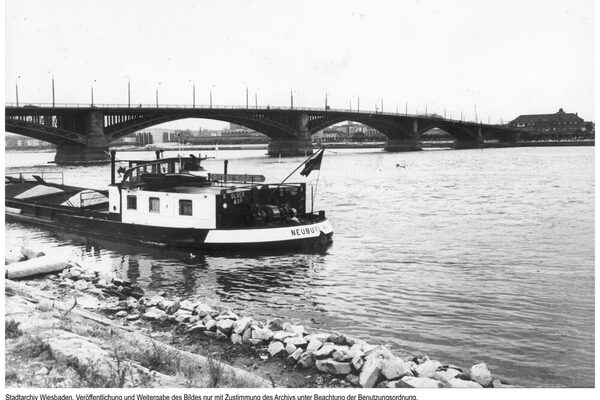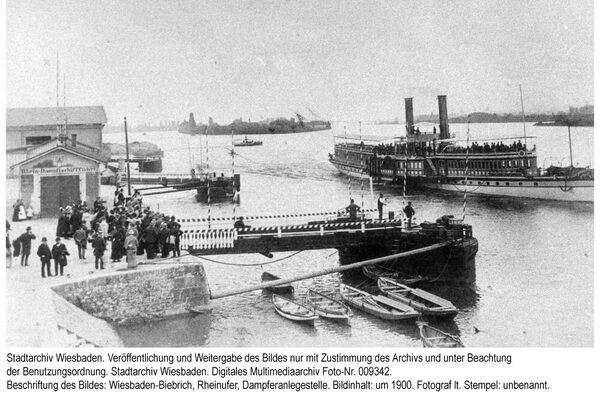Shipping
The tradition of shipping in Wiesbaden and the surrounding area dates back to ancient times. The fish-rich river was used for food supplies, and ferries operated between the two banks of the Rhine. Up until the 19th century, supra-regional traffic was hampered by the current conditions, numerous customs posts and stacking points, which forced reloading. The uphill journey in the mountainous section could only be accomplished with a horse-drawn carriage with the help of local residents. The French occupation led to the abolition of customs duties around 1800; the Rhine Navigation Act of 1831 also abolished stacking rights, enabling the largely smooth exchange of goods across the Rhine even before the founding of the German Customs Union.
A major technical and economic turnaround began in 1816, when the first steam-powered ships came from England across the Rhine to Cologne and Koblenz. The first companies for scheduled services and passenger transportation were founded. In 1831, the Biebrich jetty was declared a Rhine port with open storage for goods and remained a port of call for freight and passenger traffic. The modern development of freight transport began with the introduction of tugboats around 1830 and the expansion work around the Binger Loch, which improved transit. At the end of this decade, there were signs of a shift in traffic flows to the right bank of the Rhine, leading to the so-called Mainz Fog Boy's Prank in 1841.
After the founding of the German Empire in 1871, further restrictions were lifted, and passenger and freight transportation increased from year to year. According to statistics from the Wiesbaden Chamber of Commerce, the total number of passengers transported in the Rhine port of Biebrich rose from 137,258 (1874) to 161,762 (1881). The number of goods transported also increased by a quarter in the same period. In 1883, a total of 11,440 steamships and 1,540 sailing ships were registered. However, the latter had not been used since 1905. At the same time, rafting lost importance at the end of the 19th century after a temporary boom in the 1870s. On 01.05.1827, regular passenger and express freight services between Mainz and Cologne were launched by the Prussian-Rhenish Steamship Company. As there were initially only landing stages in Cologne, Bonn, Koblenz and Mainz, passengers at the other stations had to be brought to the ships by boatmen using barges. The first landing stage in Biebrich was built in 1832 by the Cologne Steamship Company. 1867 was the founding year of today's Köln-Düsseldorfer-Dampfschifffahrtsgesellschaft. In 1927, the first passenger motor ship was added to the fleet. From 1950, the Dutch competitor offered trips from Amsterdam to Wiesbaden in its floating hotels. Today, the fleet has twelve larger ships that sail the Rhine, Main and Moselle all year round.
The Bingen Waterways and Shipping Office operates a branch office to safeguard shipping in the Wiesbaden section, which is passed by 66,000 ships carrying around 60 million tons of goods every year. In October 2009, the office moved into a new office building in Schierstein harbor, which cost € 3.5 million.
Literature
Mentzel, Rolf: Shipping. In: The Upper Middle Rhine. Geschichte einer Landschaft, Museum Wiesbaden (ed.), H. 4, April 1975 [p. 6 f.].
Schütz, Friedrich: Die Rheinschifffahrtsakte von 1831. In: Mainz Wirtschaftsgeschichte, H. 1, Mainz 1981.
Newspaper clippings collection Stadtarchiv Wiesbaden, "Schifffahrt".

